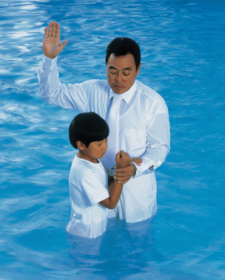
FAIR is a non-profit organization dedicated to providing well-documented answers to criticisms of the doctrine, practice, and history of The Church of Jesus Christ of Latter-day Saints.
DavidSmith (talk | contribs) (part of content conslidation and simplification project) |
m (BOT: change ((Navigation BoM}} to {{Navigation:Book of Mormon}}, replaced: {{Navigation Book of Mormon}} → {{Navigation:Book of Mormon}}) |
||
| Line 1: | Line 1: | ||
{{Main Page}} | {{Main Page}} | ||
{{Navigation Book of Mormon}} | {{Navigation:Book of Mormon}} | ||
<onlyinclude> | <onlyinclude> | ||
| Line 7: | Line 7: | ||
[[File:Baptism_image.png|225px|thumb|right|'''Figure 1.''' Latter-day Saint father baptizes son. Courtesy of LDS Blogs.]] | [[File:Baptism_image.png|225px|thumb|right|'''Figure 1.''' Latter-day Saint father baptizes son. Courtesy of LDS Blogs.]] | ||
==Introduction to Criticism== | |||
It is claimed by critics of the [https://archive.bookofmormoncentral.org/node/538 Book of Mormon] that it's mention of "baptism" early in the text is [[Question: What is an anachronism, and what should be borne in mind when assessing the Book of Mormon (or any other text) for supposed "anachronisms"?|anachronistic]].<ref>For examples from the text of the Book of Mormon, see [https://www.churchofjesuschrist.org/study/scriptures/bofm/2-ne/31.13,14,17?lang=eng&clang=eng#p13,14,17 2 Nephi 31: 13, 14, 17]; [https://www.churchofjesuschrist.org/study/scriptures/bofm/mosiah/18.21?lang=eng&clang=eng#p21 Mosiah 18:21]; [https://www.churchofjesuschrist.org/study/scriptures/bofm/mosiah/21.35?lang=eng&clang=eng#p35 Mosiah 21:35]. For criticism, see William J. Whalen, ''The Latter-day Saints in the Modern World'' (Notre Dame, IN: University of Notre Dame Press, 1967), 45: "Other words which the Nephites could hardly have known are baptize, church, gospel, barges, etc."</ref> | It is claimed by critics of the [https://archive.bookofmormoncentral.org/node/538 Book of Mormon] that it's mention of "baptism" early in the text is [[Question: What is an anachronism, and what should be borne in mind when assessing the Book of Mormon (or any other text) for supposed "anachronisms"?|anachronistic]].<ref>For examples from the text of the Book of Mormon, see [https://www.churchofjesuschrist.org/study/scriptures/bofm/2-ne/31.13,14,17?lang=eng&clang=eng#p13,14,17 2 Nephi 31: 13, 14, 17]; [https://www.churchofjesuschrist.org/study/scriptures/bofm/mosiah/18.21?lang=eng&clang=eng#p21 Mosiah 18:21]; [https://www.churchofjesuschrist.org/study/scriptures/bofm/mosiah/21.35?lang=eng&clang=eng#p35 Mosiah 21:35]. For criticism, see William J. Whalen, ''The Latter-day Saints in the Modern World'' (Notre Dame, IN: University of Notre Dame Press, 1967), 45: "Other words which the Nephites could hardly have known are baptize, church, gospel, barges, etc."</ref> | ||
The necessary linguistic, theological, and historical background to refute this claim can be found by appeal to the Hebrew Bible and the work of scholar Brant Gardner. | The necessary linguistic, theological, and historical background to refute this claim can be found by appeal to the Hebrew Bible and the work of scholar Brant Gardner. | ||
==Response to Criticism== | |||
===Uses of "Rachats" and "Tabal"=== | |||
The concept of immersion is part-and-parcel of the [https://en.wikipedia.org/wiki/Hebrew_Bible Hebrew Bible]; for example, the [https://en.wikipedia.org/wiki/Hebrew_language Hebrew] verb meaning “to wash” ''רחץ'' (rachats) appears 74 times in 73 verses in the [https://en.wikipedia.org/wiki/Old_Testament Old Testament] | The concept of immersion is part-and-parcel of the [https://en.wikipedia.org/wiki/Hebrew_Bible Hebrew Bible]; for example, the [https://en.wikipedia.org/wiki/Hebrew_language Hebrew] verb meaning “to wash” ''רחץ'' (rachats) appears 74 times in 73 verses in the [https://en.wikipedia.org/wiki/Old_Testament Old Testament]—often having the meaning of a full immersion of either a person or an object.<ref>[https://www.churchofjesuschrist.org/study/scriptures/ot/ex/2?lang=eng Exodus 2:5]; [https://www.churchofjesuschrist.org/study/scriptures/ot/1-kgs/22.38?lang=eng 1 Kings 22:38].</ref> | ||
Another Hebrew verb,''טבל'' (tabal), appears 16 times in the Old | Another Hebrew verb,''טבל'' (tabal), appears 16 times in the Old Testament—having the meaning of "to dip" or "to immerse;" all part-and-parcel of "baptism."<ref>[https://www.churchofjesuschrist.org/study/scriptures/ot/gen/37.31?lang=eng Genesis 37:31]; [https://www.churchofjesuschrist.org/study/scriptures/ot/num/19.18?lang=eng Numbers 19:18]; [https://www.churchofjesuschrist.org/study/scriptures/ot/2-kgs/5.14?lang=eng 2 Kings 5:14]; [https://www.churchofjesuschrist.org/study/scriptures/ot/job/9.31?lang=eng Job 9:31].</ref> | ||
The [https://en.wikipedia.org/wiki/Septuagint Septuagint] translates ''טבל'' using the Greek verb meaning “to | The [https://en.wikipedia.org/wiki/Septuagint Septuagint] translates ''טבל'' using the Greek verb meaning “to baptize”—βαπτιζω. This verb (and correlative translation in the Septuagint) occurs in [https://www.churchofjesuschrist.org/study/scriptures/ot/2-kgs/5.14?lang=eng 2 Kings 5:14] and [https://www.churchofjesuschrist.org/study/scriptures/ot/isa/21.4?lang=eng Isaiah 21:4], in the proto-canonical texts, and [https://www.biblegateway.com/verse/en/Judith%2012%3A7 Judith 12:7] and [https://www.biblegateway.com/passage/?search=Sirach+34%3A25&version=GNT Sirach 34:25] in the [https://en.wikipedia.org/wiki/Apocrypha Apocrypha]. | ||
[[File:CalyAnn_Barnett_Image.png|350px|thumb|center|'''Figure 2.''' Basketball star Dwyane Wade attends the baptism of friend Calyann Barnett-Watson as she became a member of The Church of Jesus Christ of Latter-day Saints. Courtesy of ldsdaily.com]] | [[File:CalyAnn_Barnett_Image.png|350px|thumb|center|'''Figure 2.''' Basketball star Dwyane Wade attends the baptism of friend Calyann Barnett-Watson as she became a member of The Church of Jesus Christ of Latter-day Saints. Courtesy of ldsdaily.com]] | ||
===Historical and Theological Context=== | |||
Though, this only gets us the word "baptism." It does not get us the proper intellectual context in which baptism might emerge. Latter-day Saint scholar Brant Gardner provided this context in his 6 volume commentary on the Book of Mormon, ''Second Witness''.<ref>Brant A. Gardner, ''Second Witness: Analytical and Contextual Commentary on the Book of Mormon'', 6 vols. (Salt Lake City: Greg Kofford Books, 2007), 2:433–36.</ref> Scholar Jonathan Lawrence has a book-length treatment on ritual bathing in the Hebrew Bible.<ref>Jonathan Lawrence, ''Washing in Water: Trajectories of Ritual Bathing in the Hebrew Bible and Second Temple Literature'' (Atlanta, GA: Society of Biblical Literature, 2006).</ref> | Though, this only gets us the word "baptism." It does not get us the proper intellectual context in which baptism might emerge. Latter-day Saint scholar Brant Gardner provided this context in his 6 volume commentary on the Book of Mormon, ''Second Witness''.<ref>Brant A. Gardner, ''Second Witness: Analytical and Contextual Commentary on the Book of Mormon'', 6 vols. (Salt Lake City: Greg Kofford Books, 2007), 2:433–36.</ref> Scholar Jonathan Lawrence has a book-length treatment on ritual bathing in the Hebrew Bible.<ref>Jonathan Lawrence, ''Washing in Water: Trajectories of Ritual Bathing in the Hebrew Bible and Second Temple Literature'' (Atlanta, GA: Society of Biblical Literature, 2006).</ref> | ||
==Conclusion== | |||
Critics have long sought to demonstrate that certain anachronisms are damning for the Book of Mormon’s historicity. In this case, persuasive evidence can be marshaled to suggest that the mention of “baptism” is simply not one of them.<ref>This article largely follows the approach taken in Robert S. Boylan, "Responding to William Whalen on Alleged Anachronisms in the Book of Mormon," <https://scripturalmormonism.blogspot.com/2018/05/responding-to-william-whalen-on-alleged.html?fbclid=IwAR0X9WCXwkORzeRoRhzihqHCi4TlRSrVVJKDLXDQwSZ62VhKSarS8zs1ulM> (9 June 2020). FairMormon thanks Robert for his great research used in this article.</ref> | Critics have long sought to demonstrate that certain anachronisms are damning for the Book of Mormon’s historicity. In this case, persuasive evidence can be marshaled to suggest that the mention of “baptism” is simply not one of them.<ref>This article largely follows the approach taken in Robert S. Boylan, "Responding to William Whalen on Alleged Anachronisms in the Book of Mormon," <https://scripturalmormonism.blogspot.com/2018/05/responding-to-william-whalen-on-alleged.html?fbclid=IwAR0X9WCXwkORzeRoRhzihqHCi4TlRSrVVJKDLXDQwSZ62VhKSarS8zs1ulM> (9 June 2020). FairMormon thanks Robert for his great research used in this article.</ref> | ||
{{endnotes sources}} | {{endnotes sources}} | ||
==References== | |||
{{Reflist}} | |||

It is claimed by critics of the Book of Mormon that it's mention of "baptism" early in the text is anachronistic.[1]
The necessary linguistic, theological, and historical background to refute this claim can be found by appeal to the Hebrew Bible and the work of scholar Brant Gardner.
The concept of immersion is part-and-parcel of the Hebrew Bible; for example, the Hebrew verb meaning “to wash” רחץ (rachats) appears 74 times in 73 verses in the Old Testament—often having the meaning of a full immersion of either a person or an object.[2]
Another Hebrew verb,טבל (tabal), appears 16 times in the Old Testament—having the meaning of "to dip" or "to immerse;" all part-and-parcel of "baptism."[3]
The Septuagint translates טבל using the Greek verb meaning “to baptize”—βαπτιζω. This verb (and correlative translation in the Septuagint) occurs in 2 Kings 5:14 and Isaiah 21:4, in the proto-canonical texts, and Judith 12:7 and Sirach 34:25 in the Apocrypha.

Though, this only gets us the word "baptism." It does not get us the proper intellectual context in which baptism might emerge. Latter-day Saint scholar Brant Gardner provided this context in his 6 volume commentary on the Book of Mormon, Second Witness.[4] Scholar Jonathan Lawrence has a book-length treatment on ritual bathing in the Hebrew Bible.[5]
Critics have long sought to demonstrate that certain anachronisms are damning for the Book of Mormon’s historicity. In this case, persuasive evidence can be marshaled to suggest that the mention of “baptism” is simply not one of them.[6]

FAIR is a non-profit organization dedicated to providing well-documented answers to criticisms of the doctrine, practice, and history of The Church of Jesus Christ of Latter-day Saints.
We are a volunteer organization. We invite you to give back.
Donate Now